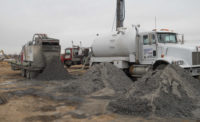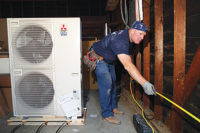Believe it or not, sales of oil furnaces are increasing.
Granted, they’re still not flying off the shelves at the frequency they were during the peak years of the 1990s, when annual sales sometimes topped 150,000 units, but sales are picking up a bit from the all-time low of 32,144 units sold in 2013.
According to the Air-Conditioning, Heating, and Refrigeration Institute (AHRI), as of September, year-to-date U.S. shipments of oil warm-air furnaces increased 9.7 percent to 23,996, compared with 21,879 units shipped during the same period in 2014. And, in 2014, year-to-date sales totaled 34,725 units, an increase of 8 percent over shipments in 2013. Prior to that, sales of oil furnaces had been declining precipitously since 2004, but it seems that lower oil prices, local incentives, and pent-up demand may be fueling this small surge in sales.
GROWING DEMAND
Heating oil is known for its cost volatility, and many homeowners have painful memories of prices topping $4 per gallon just a few years ago. That spike in utility bills caused some homeowners to convert to gas furnaces (if natural gas was available) or heat pumps, but many stuck with their oil furnaces, waiting for the day when prices would fall back to earth. It seems that’s happened this year, as the U.S. Energy Information Association (EIA) predicts residential heating oil will cost $2.73 per gallon over the course of 2015 and then continue dropping to $2.65 per gallon in 2016. Even better yet, the EIA believes those price drops are the beginning of a long-term trend rather than just a short-term reprieve.
The lower cost of heating oil has most likely encouraged customers to believe it is worthwhile to invest in new equipment that has higher levels of efficiency, said John Huber, president of the National Oilheat Research Alliance in Alexandria, Virginia. “I think oil furnaces have the potential for long-term popularity based on their high efficiency levels and lower installation costs. We hope sales will return to — and stay at — the levels they achieved 10 years ago.”
Lower oil prices are definitely having a positive effect on sales, said Marc Chénier, general manager of Dettson Industries in Quebec, Canada. “We started seeing an increase in sales in 2014, when our sales increased 12 percent over 2013. So far, in 2015, it’s more along the lines of a 15 percent increase. We think the trend is becoming more sustainable, particularly in the Northeastern U.S. and Eastern Canada.”
While Lennox has also seen increases in sales of oil furnaces in the Northeastern U.S., sales are up in the Midwest and the Salt Lake City region, as well, said Kim Do, heating product manager, Lennox Intl. Inc. “Sales of oil furnaces will most likely trend with the price of oil with an anticipation they will continue to increase over the next year. While they may not be as popular as they used to be because of the volatility of oil prices, they’ll continue to have a presence in the market due to the limited access to natural gas in many areas of the country.”
In addition to the lower price of heating oil, pent-up demand is also driving sales of oil furnaces, noted Chénier. “Equipment can only be repaired for so long, and, at some point, it makes more sense to buy a new unit that will offer much more efficient operation with a higher AFUE.”
Ralph Adams, service manager for Parker Fuel Co. Inc. in Ellicott City, Maryland, agrees, noting that, up until now, homeowners have been putting off replacements and upgrades due to the bad economy. “In our area, sales were very slow, with most homeowners choosing to repair instead of replace. They said they just didn’t have the money. Now, I see these same homeowners replacing their equipment when they would have made the repairs just a few years ago.”
Incentives are also driving sales of oil furnaces, said Rosemarie Bartchak, sales and marketing manager for Boyertown Furnace Co. in Boyertown, Pennsylvania. “I’ve kept records for our company for more than 35 years, and there appears to be a cyclical demand every 10-12 years or whenever there are large rebates available.”
Rebates and favorable financing terms have definitely helped spur sales of oil furnaces, said David Fein, vice president of sales and marketing at Robison Oil in Elmsford, New York. “The incentives and rebates from the state of New York have helped dramatically. The New York State Energy Research and Development Authority (NYSERDA) programs offers a 10 percent rebate, and they also extend financing at around 3.49 percent for those who qualify. We also participate in the subsidy program for low-income folks who need help, and we have some great financing programs through Synchrony, which used to be GE. With all the tools we have available, we can match and design comfortable systems for our customers that are also palatable to them financially.”
OIL BENEFITS
While the volatility of heating oil prices may lead some customers to consider changing over to a heat pump or gas-fired furnace, contractors need to make the argument that there is a lot to like about oil furnaces, said Doug Woosnam, executive vice president of the Delaware Valley Fuel Dealers Association (DVFDA). “The equipment is as good as — or even better than — the other fuels in terms of reliability, cleanliness, and efficiency, and when compared to gas oil is considered to be a safer fuel choice. And, while heat pumps added to an oil system can be a wise choice, a heat pump by itself with electric backup heat in this market is not a wise choice.”
That’s because electricity is very expensive in many parts of the country. “When a heat pump is properly sized, it will heat a home by itself until somewhere around 32°F. At that point, the electric supplemental heat will kick in, which is the most expensive way to heat a home,” said Adams. “In our area, the cost of electricity is equal to heating oil being $6.20 per gallon.”
As for converting from oil to gas, that can be more expensive and time-consuming than customers anticipate, said Fein. “Customers often think that gas is much cheaper and the equipment is quieter and requires less maintenance, but it’s expensive to convert to gas, and, at least in our area, it can take up to a year to get all the permits and approvals and then bring in the gas line. If customers opt for a new, modern oil furnace, we can usually install that within a week, and instead of waiting around for a year for a gas conversion, they could be enjoying the comfort, quiet operation, and efficiency of their new equipment.”
Oil furnace technology has also improved, with many manufacturers offering more efficient burners for greater fuel economy as well as variable-speed blowers, which improve comfort and IAQ, said Do. “Lennox’s SLO185V oil furnace is equipped with a variable-speed motor and SilentComfort™ technology and features quiet operation, consistent heating comfort, and improved humidity control.”
Boyertown Furnace currently offers an oil furnace/burner combination with an electronically commutated motor (ECM) that delivers two-stage oil heating, said Bartchak. “When installed with the proper thermostats, a homeowner can enjoy warm-air heating that is quiet and comfortable, efficient, and less expensive.”
In addition to higher efficiencies, today’s oil furnaces are extremely reliable, which is what homeowners are looking for, said Chénier. “People like predictability and security. Oil is safe. It’s been around for a very long time and offers great comfort. Today’s furnaces are also smaller and quieter, which are very nice evolutions.”
Even with the advances in efficiency and comfort, few believe that oil furnaces will ever be as popular as they once were. “There is a lot of misinformation out there about oil heat, and it’s important for contractors to educate customers about its benefits,” said Fein. “If we do that, then I think oil furnaces will continue to thrive.”
Publication date: 12/21/2015
Want more HVAC industry news and information? Join The NEWS on Facebook, Twitter, and LinkedIn today!











